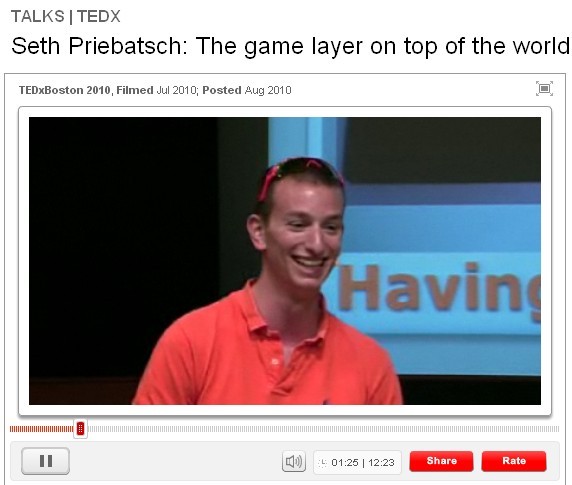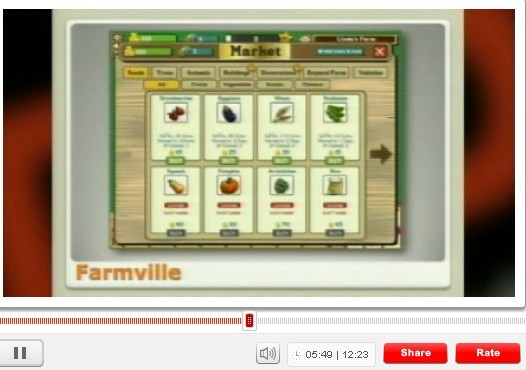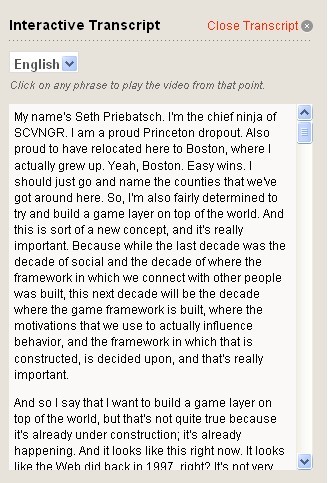TED会议:Seth Priebatsch谈游戏中的用户协作社交机制
Dylan Woodbury运用塞思·普瑞巴什在TED大会上分享的四种游戏机制的基本原理,分析了社交游戏吸引玩家持续不断登陆的原因,以及如何在这些游戏中引入社区机制,在玩家中制造群体感情。从中,我们或许可以窥视到为何这么多的人会沉迷在如此简单的游戏中,又该如何利用社交网络制造更多的乐趣。
大多数社交游戏,比如《开心农场》等,它们每天有上百万的玩家,但是这些游戏没有完全利用社交网络。
Scvngr首席执行官塞思·普瑞巴什(Seth Priebatsch)在TED大会上提出了四种游戏机制:约定机制、身份与影响力、进度机制、社区机制。在过去的十年中,我们已经建立了一个以 Facebook和开放性社会化图谱为标志的成熟社交网络体系。我们在这里让人与人之间的距离越来越小,沟通越来越方便。塞思认为,社交网络的功能在于连接用户,而游戏能从更深次上影响用户行为,而这种影响很大程度上是无形的。正因如此,我们需要了解哪些游戏机制能影响用户行为,又是如何影响用户行为的。
约定机制:为了成功完成游戏,用户需要在事先约定的时间和地点完成事先约定的任务,Facebook上的农场游戏Farmville也是这一机制的拥趸,用户们不得不赶着钟点为他们的作物浇水。
身份与影响力:用户通过社会压力影响其他用户行为的能力。在游戏中,用户也想要不断升级已显示自己的能力。
进度机制:通过将一项大任务分割成若干小任务而不断积累成果、达成目标的过程。
社区机制:通过团队协作达成目标。这个最近只在最大的社交游戏《开心农场》中实现了,以合作种植的方式,朋友们必须在一段时间内一起种植一定数量的一种或几种植物。Zynga敢于根据游戏理论尝试值得表扬,但是社区机制远不止这些,比目前实现的要强大的多了。开心农场中合作种植失败的原因是其中缺乏竞争,因此少了乐趣。
基于团队的竞争可以产生很多乐趣,玩家不再仅仅为了等级或者经验(进度机制)而玩,而且必须和朋友一起合作(身份与影响力机制),成为一个团队的一部分(社区机制)。
现在来想游戏的结构,开心农场的结构其实非常的无趣,只是每隔几个小时按一个按钮。如果当中融合了社区机制会变得怎么样呢?
这些想法让我自己利用社区机制设计了一个社交游戏,为了让玩家感兴趣、保持玩家持续玩这个游戏、让他们关了电脑还能继续讨论游戏。我设计了以公司为主题的游戏:《企业》(Enterprise)。游戏开始的时候你有两个选择:创办你自己的公司或者加入别人的公司。你可以加入你朋友的公司,公司拥有者会给你分配一个职位。
根据公司的大小或者你和你朋友的关系,你会被分配一个职位,职位包括普通劳动者(玩法就类似于农场了)、创意型职位(提出一系列吸引投资者的想法)、研究型的职位(通过调查测试想法)、广告职位(宣传自己的公司)、社交职位(与其他公司合作)、管理职位(监督其他人)等。
个人工作者可以通过完成任务获得经验,获得公司拥有者的认可还可以获得额外的奖金,每周可以获得工资,每个职位都有最低工资。在团队中努力工作,可以提升公司股价,股价每周变动,公司的拥有者可以雇佣、解雇、发放奖金、提升某个工人、把某个工人降职,另一方面,工人可以和公司共同努力、也可以对公司提出抗议,也可以在工资发完后马上不干了。
随着公司的成长,新的工作机会和选择也会出现,包括和其他公司合作。如果一个公司的股价持续上涨,人们(包括朋友和陌生人)都可以购买公司股票,公司可以分红并且向投资者发送进度报告以吸引更多的投资者,这也是影响股价的一个因素。
这个游戏的伟大之处在于形成了一个庞大的团队合作意识,这个机制可以让玩家在游戏之外继续讨论。在工作或者在学校中,人们可以和其他玩家继续讨论策略等,每个人在同一条船上,每个人又为了自己的经验等级而努力,也为个人经历而努力以便以后申请进入更大的公司或者自己开公司。
无论怎么说,这只是一个实现社区机制而又包含个人完成度元素的游戏例子,旨在给大家创造更有意义的游戏结构提供一点小启发。
关于塞思·普瑞巴什:
SCVNGR的创始人,提供基于地理位置的手机游戏服务。
关于TED:
TED是一个会议的名称,它是由Chris Anderson创立的幼苗基金会做的,每一年的春季在美国汇集众多科学家、设计师、文学家、音乐家等领域的杰出人物,在TED大会上分享他们关于科技、社会、人的思考和探索。大凡有机会来到 TED 大会现场作演讲的均有非同寻常的经历,他们要么是某一领域的佼佼者,要么是某一新兴领域的开创人,要么是做出了某些足以给社会带来改观的创举。
My name’s Seth Priebatsch. I’m the chief ninja of SCVNGR. I am a proud Princeton dropout. Also proud to have relocated here to Boston, where I actually grew up. Yeah, Boston. Easy wins. I should just go and name the counties that we’ve got around here. So, I’m also fairly determined to try and build a game layer on top of the world. And this is sort of a new concept, and it’s really important. Because while the last decade was the decade of social and the decade of where the framework in which we connect with other people was built, this next decade will be the decade where the game framework is built, where the motivations that we use to actually influence behavior, and the framework in which that is constructed, is decided upon, and that’s really important.
And so I say that I want to build a game layer on top of the world, but that’s not quite true because it’s already under construction; it’s already happening. And it looks like this right now. It looks like the Web did back in 1997, right? It’s not very good. It’s cluttered. It’s filled with lots of different things that, in short, aren’t that fun. There are credit card schemes and airline mile programs and coupon cards and all these loyalty schemes that actually do use game dynamics and actually are building the game layer, they just suck. They’re not very well designed, right? So, that’s unfortunate. But luckily, as my favorite action hero, Bob the Builder, says, “We can do better. We can build this better.” And the tools, the resources that we use to build a game layer are game dynamics themselves. And so the crux of this presentation is going to go through four really important game dynamics, really interesting things, that, if you use consciously, you can use to influence behavior, both for good, for bad, for in-between. Hopefully for good. But this is sort of the important stages in which that framework will get built, and so we want to all be thinking about it consciously now.
Just before we jump into that, there’s sort of a question of: why is this important? I’m sort of making this claim that there is a game layer on top of the world, and that it’s very important that
we build it properly. The reason that it’s so important is that, the last decade, what we’ve seen has been building the social layer, has been this framework for connections, and construction on that layer is over, it’s finished. There’s still a lot to explore. There’s still a lot of people who are trying to figure out social and how do we leverage this and how do we use this, but the framework itself is done, and it’s called Facebook. And that’s okay, right? A lot of people are very happy with Facebook. I like it quite a lot. They’ve created this thing called the Open Graph, and they own all of our connections. They own half a billion people. And so when you want to build on the social layer, the framework has been decided; it is the Open Graph API. And if you’re happy with that, fantastic. If you’re not, too bad. There’s nothing you can do.
But this next decade — and that’s a real thing. I mean, we want to build frameworks in a way that makes it acceptable and makes it, you know, productive down the road. So, the social layer is all about these connections. The game layer is all about influence. It’s not about adding a social fabric to the Web and connecting you to other people everywhere you are and everywhere you go. It’s actually about using dynamics, using forces, to influence the behavior of where you are, what you do there, how you do it. That’s really, really powerful, and going to be more important than the social layer. It’s going to affect our lives more deeply and perhaps more invisibly. And so it’s incredibly critical that at this moment, while it’s just getting constructed, while the frameworks like Facebook, like the Open Graph, are being created for the game layer equivalent, that we think about it very consciously, and that we do it in a way that is open, that is available, and that can be leveraged for good.
And so that’s what I want to talk about for game dynamics, because construction has just begun, and the more consciously we can think about this, the better we’ll be able to use it for anything that we want. So like I said, the way that you go through and build on the game layer is not with glass and steal and cement. And the resources that we use are not this two-dimensional swath of land that we have. The resources are mindshare and the tools, the raw materials are these game dynamics. So with that, you know, a couple game dynamics to talk about. Four. Back at SCVNGR, we like to joke that with seven game dynamics, you can get anyone to do anything. And so today, I’m going to show you four, because I hope to have a competitive advantage at the end of this, still.(Laughter)
So the first one, it’s a very simple game dynamic. It’s called the appointment dynamic. And this is a dynamic in which to succeed, players have to do something at a predefined time, generally at a predefined place. And these dynamics are a little scary sometimes, because you think, you know, other people can be using forces that will manipulate how I interact, what I do, where I do it, when I do it. This sort of loss of free will that occurs in games can be frightening, so with each dynamic, I’m going to give three examples — one that shows how this is already being used in the real world, so you can sort of rationalize it a little bit, one that shows it in what we consider a conventional game — I think everything is a game, this is sort of more of a what you would think is a game played on a board or on a computer screen, and then one how this can be used for good, so we can see that these forces can really be very powerful.
So the first one — the most famous appointment dynamic in the world — is something called happy hour. So I just recently dropped out of Princeton and actually ended up for the first time in a bar, and I saw these happy hour things all over the place, right. And this is simply an appointment dynamic. Come here at a certain time, get your drinks half off. To win, all you have to do is show up at the right place at the right time. This game dynamic is so powerful, that it doesn’t just influence our behavior, it’s influenced our entire culture. That’s a really scary thought, that one game dynamic can change things so powerfully.
It also exists in more conventional game forms. I’m sure you’ve all heard of Farmville by now. If you haven’t, I recommend playing it. You won’t do anything else with the rest of your day.
Farmville has more active users than Twitter. It’s incredibly powerful, and it has this dynamic where you have to return at a certain time to water your crops — fake crops — or they wilt. And this is so powerful that, when they tweak their stats, when they say your crops wilt after eight hours, or after six hours, or after 24 hours, it changes the life-cycle of 70 million-some people during the day. They will return like clockwork at different times. So if they wanted the world to end, if they wanted productivity to stop, they could make this a 30-minute cycle, and no one could do anything else. (Laughter) That’s a little scary.
But this could also be used for good. This is a local company called Vitality, and they’ve created a product to help people take their medicine on time. That’s an appointment. It’s something that people don’t do very well. And they have these GlowCaps which, you know, flash and email you and do all sorts of cool things to remind you to take your medicine. This is one that isn’t a game yet, but really should be. You should get points for doing this on time. You should lose points for not doing this on time. They should consciously recognize that they’ve built an appointment dynamic and leverage the games. And then you can really achieve good in some interesting ways.
We’re going to jump onto the next one, maybe. Yes. Influence and status. So this is one of the most famous game dynamics. It’s used all over the place. It’s used in your wallets, right now. We all want that credit card on the far left because it’s black. And you see someone at CVS or — not CVS — at Christian Dior or something, and then … I don’t know. I don’t have a black card; I’ve got a debit card. (Laughter) So they whip it out. And you see men, they have that black card. I want that because that means that they’re cooler than I am, and I need that.
And this is used in games as well. “Modern Warfare,” one of the most successful selling games of all time. I’m only a level four, but I desperately want to be a level 10, because they’ve got that cool red badge thing, and that means that I am somehow better than everyone else. And that’s very powerful to me. Status is really good motivator.
It’s also used in more conventional settings and can be used more consciously in conventional settings. School — and remember, I made it through one year, so I think I’m qualified to talk on school — is a game, it’s just not a terribly well-designed game, right. There are levels. There are C. There are B. There is A. There are statuses. I mean, what is valedictorian, but a status? If we called valedictorian a “white knight paladin level 20,” I think people would probably work a lot harder. (Laughter) So school is a game, And there have been lots of experimentations on how we do this properly. But let’s use it consciously. Like why have games that you can lose? Why go from an A to an F or a B to a C? That sucks. Why not level-up? And at Princeton, they’ve actually experimented with this, where they have quizzes where you gain experience points, and you level up from B to an A. And it’s very powerful. It can be used in interesting ways.
The third one I want to talk about quickly is the progression dynamic, where you have to sort of make progress, you have to move through different steps in a very granular fashion. This is used all over the place, including LinkedIn, where I am an un-whole individual. I am only 85 percent complete on LinkedIn, and that bothers me. And this is so deep-seated in our psyche that, when we’re presented with a progress bar and presented with easy, granular steps to take to try and complete that progress bar, we will do it. We will find a way to move that blue line. all the way to the right edge of the screen.
This is used in conventional games as well. I mean, you see this is a paladin level 10, and that’s a paladin level 20, and if you were going to fight, you know, orcs on the fields of Mordor against the Raz al Ghul, you’d probably want to be the bigger one, right. I would. And so people work very hard to level-up. “World of Warcraft” is one of the most successful games of all time. The average player spends something like six, six-and-a-half hours a day on it. Their most dedicated players, it’s like a full-time job. It’s insane. And they have these systems where you can level-up. And that’s a very powerful thing. Progression is powerful.
It can also be used in very compelling ways for good. One of the things that we work on at SCVNGR is how do you use games to drive traffic and drive business to local businesses, to sort of something that is very key to the economy. And here we have a game that people play. They go places, they do challenges, they earn points. And we’ve introduced a progression dynamic into it, where, by going to the same place over and over, by doing doing challenges, by engaging with the business, you move a green bar from the left edge of the screen to the right edge of the screen, and you eventually unlock rewards. And this is powerful enough that we can see that it hooks people into these dynamics, pulls them back to the same local businesses, creates huge loyalty, creates engagement, and is able to drive meaningful revenue and fun and engagement to businesses. These progression dynamics are powerful and can be used in the real world.
The final one I want to talk about — and it’s a great one to end on — is this concept of communal discovery, a dynamic in which everyone has to work together to achieve something. And communal discovery is powerful because it leverages the network that is society to solve problems. This is used in some sort of famous consumer web stories, like Digg, which I’m sure you’ve all heard of.
Digg is a communal dynamic to try to find and source the best news, the most interesting stories. And they made this into a game, initially. They had a leader board, where, if you recommended the best stories, you would get points. And that really motivated people to find the best stories. But it became so powerful, that there was actually a cabal, a group of people, the top seven on the leader board, who would work together to make sure they maintained that position. And they would recommend other people’s stories. And the game became more powerful than the goal. And they actually had to end up shutting down the leader board because, while it was effective, it was so powerful that it stopped sourcing the best stories and started having people work to maintain their leadership. So we have to use this one carefully. It’s also used in things like McDonald’s Monopoly, where the game is not the Monopoly game you’re playing, but the sort of cottage industries that form to try and find Boardwalk, right. And now they’re just looking for a little sticker that says “Boardwalk.”
But it can also be used to find real things. This is the DARPA balloon challenge, where they hid a couple balloons all across the United States and said, “Use networks. Try and find these balloons fastest, and the winner will get $40,000.” And the winner was actually a group out of MIT, where they created sort of a pyramid scheme, a network, where the first person to recommend the location of a balloon got $2,000 and anyone else to push that recommendation up also got a cut of it. And in 12 hours, they were able to find all these balloons, all across the country, right. Really powerful dynamic.
And so, I’ve got about 20 seconds left, so if I’m going to leave you with anything, last decade was the decade of social. This next decade is the decade of games. We use game dynamics to build on it. We build with mindshare. We can influence behavior. It is very powerful. It is very exciting. Let’s all build it together, let’s do it well and have fun playing.(source:duowan/ted)
注解:本文中文部分采用多玩网的翻译,英文部分直接采纳Seth Priebatsch在TED上面的演讲稿










































 闽公网安备35020302001549号
闽公网安备35020302001549号